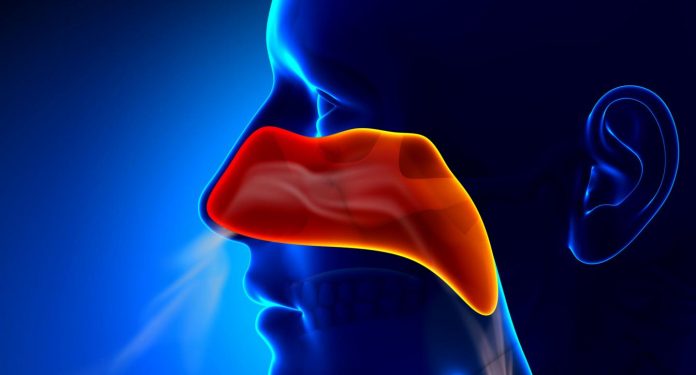

Our immune system has developed sophisticated ways to protect us from infection by the bacteria that we are bombarded with every day. However, how we are kept safe from the bacteria that enter into our airway through our nose has largely remained a mystery.
A novel mechanism has been uncovered by the researchers at Massachusetts Eye and Ear that involves the release of exosomes, tiny fluid-filled sacs, that serve two protective purposes. They attack the bacteria and act to shuttle protective antimicrobial proteins from the front of the nose to the back along the airway, protecting other cells against the bacteria before it gets too far into the body. This work, titled, “Exosome swarms eliminate airway pathogens and provide passive epithelial immunoprotection through nitric oxide” is published today in the Journal of Allergy and Clinical Immunology (JACI).
“Similar to kicking a hornets nest, the nose releases billions of exosomes into the mucus at the first sign bacteria, killing the bacteria and arming cells throughout the airway with a natural, potent defense” says senior author Benjamin Bleier, M.D., a sinus surgeon at Massachusetts Eye and Ear and associate professor of otolaryngology at Harvard Medical School. “It’s almost like this swarm of exosomes vaccinates cells further down the airway against a microbe before they even have a chance to see it.”
The team had noticed, through previous work, that proteins in the cells of the nasal cavity were also present in patients’ nasal mucus. The team wanted to know why and how these proteins were moving from the cells into the nasal mucus, hypothesizing that exosomes had something to do with that process. They sought to determine whether mucosal exposure to inhaled pathogens stimulates a defensive swarm of microbiocidal exosomes, which also donate their antimicrobial cargo to adjacent epithelial cells. They found that nasal mucosa–derived exosomes (NMDEs) harbor immunodefensive proteins and are capable of rapid interepithelial protein transfer.
To study this, the team cultured cells from patients’ mucus. They then simulated an exposure to bacteria and measured both the number and composition of the released exosomes. They looked at NMDE secretion after Toll-like receptor (TLR) 4 stimulation by LPS (12.5 μg/mL) in the presence of TLR4 inhibitors.
When cells at the front of the nose detect a bacterial molecule, they trigger a receptor called TLR4, which stimulates exosome release. When that happens, an innate immune response occurs within five minutes. First, the number of exosomes that are released into the nose doubles. Second, within those exosomes, a protective enzyme, nitric oxide synthase, also doubles in amount. As a well-known antimicrobial molecule, nitric oxide potently arms each exosome to defend against bacteria. The interepithelial transfer of exosomal nitric oxide (NO) synthase and nitric oxide was measured by using ELISAs and NO activity assays. Exosomal antimicrobial assays were performed with Pseudomonas aeruginosa.
The team confirmed the doubling of both the number of exosomes and of antibacterial molecules after stimulation in live patients and further showed that these stimulated exosomes were as effective as antibiotics at killing the bacteria. Finally, the team showed that the exosomes were rapidly taken up by other epithelial cells, where they were able to “donate” their antimicrobial molecules.
The authors write, “In vivo and in vitro LPS exposure induced a 2-fold increase in NMDE secretion along with a 2-fold increase in exosomal inducible nitric oxide synthase expression and function through TLR4 and inhibitor of nuclear factor κB kinase activation. LPS stimulation increased exosomal microbiocidal activity against P. aeruginosa by almost 2 orders of magnitude. LPS-stimulated exosomes induced a 4-fold increase in NO production within autologous epithelial cells with protein transfer within 5 minutes of contact. Pathway analysis of the NMDE proteome revealed 44 additional proteins associated with NO signaling and innate immune function.”
The findings not only provide further information about our immune systems. This work also uncovers a new method of drug delivery techniques through the cells in the airway that harness this transportation process. More specifically, as natural transporters, exosomes could be used to transfer inhaled packets of therapeutics to cells along the upper airway and possibly even into the lower airways and lungs. “The nose provides a unique opportunity to directly study the immune system of the entire human airway—including the lungs,” says Dr. Bleier.
